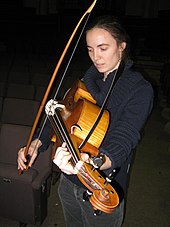Cello da spalla
This article needs additional citations for verification. (February 2014) |

The violoncello da spalla, known informally as the cello da spalla, is a small cello played braced against the shoulder.
The violoncello da spalla was designed to be played by violinists, who have limited experience playing instruments such as the viola da gamba or cello, which are held in a vertical position fixed between legs. The viola da spalla is held on the shoulder and chest, and is larger than the viola.[1]
Possible Use by Bach
Because of the variety in terminology used in the eighteenth century, it can be difficult now to determine exactly what instrument was intended in specific instances. The terms "violoncello da spalla" and "viola da spalla" tend to appear in theoretical works rather than as instrument designations from composers. However, it is possible that J. S. Bach, and perhaps other composers, might have intended the violoncello da spalla in cases where the "violoncello piccolo" is specified. This term, "violoncello piccolo", features in many of the Bach cantatas, with the parts written in a variety of clefs (bass, tenor, alto and soprano). The variety of clefs has been taken as a representation of the instrument's relatively wide range.[2] The five-string version of the instrument may have been what Bach had in mind for performing his Cello Suite No. 6 (which presents many technical problems on a four-string cello).
Musicians
- Makoto Akatsu
- Dmitry Badiarov
- François Fernandez
- Sigiswald Kuijken
- Sergey Malov
- Ryo Terakado
- Jesenka Balic Zunic
See also
- Cello
- Chest of viols
- Division viol
- Lyra viol
- Viola bastarda
- Pardessus de viole
- Viol
- Viola
- Violin
- Violone
References
